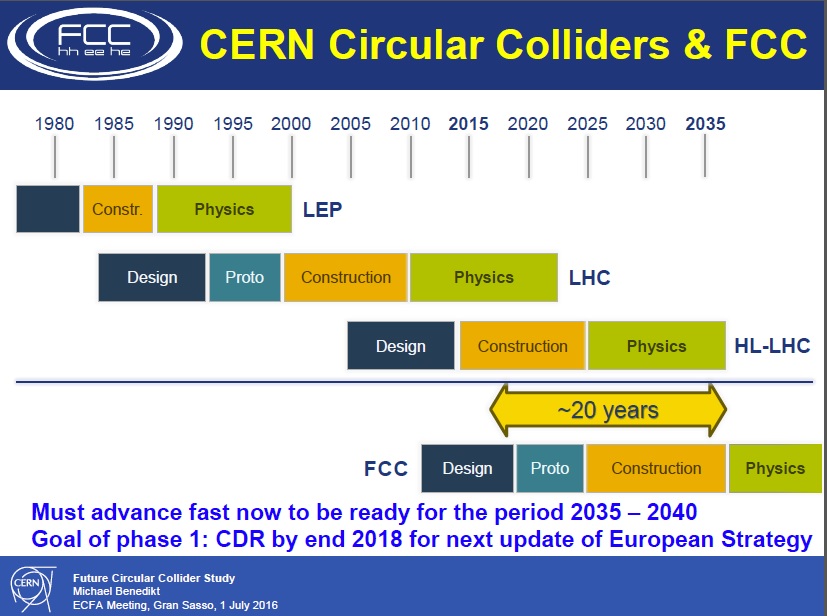Taking a closer look at LHC
|
While the LHC collisions (Run1, Run 2 ...) continue to provide good physics, different working groups are developing plans for the improvement of the LHC injector chain and a roadmap for the development and production of superconducting magnets. In "Upgrading Superconductivity" some improvements are considered. Here, other aspects are taken into account in a very brief way. Filling the LHC must be made as fast as possible. The basic period has to be reduced, resulting in shorter cycles of the PSB and PS. Moreover the SPS acceleration time must also be shortened. This has to be implemented in the short term, keeping the average thermal load constant for the PS and SPS magnets until they are felt dependable enough. All possible means to reduce beam loss must be pursued. The proposed project for a new multi-turn ejection from the PS is particularly relevant and deserves a high priority, because it is expected to reduce loss at 14 GeV/c by a factor of ~3 for the high intensity/high flux beam for the CERN Neutrino to Gran-Sasso experiment. Improvements must be implemented to prepare the injectors for delivering the ultimate type of beam to the LHC. The known bottlenecks must be treated by upgrading the equipment, and the suspected ones must be further studied. In the SPS , this includes increasing the peak RF power capability, reducing the impedance of the kickers and searching for other impedance sources. The future programme of consolidation of the SPS magnets, if decided, may provide the opportunity to improve impedance and reduce the electron cloud generation by modifying the vacuum chamber. Studies in the SPS will help confirming the interest of a new ~50 GeV synchrotron replacing the PS. The linear accelerator Linac4 remove the bottleneck at injection in the PSB. This make possible the regular delivery of the ultimate beam to the LHC, reduce its filling time and positively contribute to the overall reliability of the injector complex. We can summarize some of the considered changes in the following image
|
Future Circular Collider (FCC) In order to continue to probe the structure of matter, to understand what the smallest constituents of nature are and how they interact, it is necessary to think big and plan for the long term. Possibilities include machines that would dwarf the Large Hadron Collider, and neutrino beams crossing half a continent. Maybe the new LHC -Future Circular Collider (FCC)- could also be built in the future in Geneve. In June 2021 an international committee independently recommended a specific, 91km-circumferencelayout with afour-fold symmetry and eight surface site.
Artistic representation of FCC tunnel (Image CERN) In March 2025, after several years of intense work, CERN and international partners completed a study to assess the feasibility of a possible Future Circular Collider (FCC). Reflecting the expertise of over a thousand physicists and engineers across the globe, the report presents an overview of the different aspects related to the potential implementation of such a project. More information:
Closing the loop: Different working hypotheses (coloured rings) for a 91 km-circumference FCC placement scenario with eight surface sites, taking into account geological conditions, surface constraints, infrastructure and resources. The present LHC and SPS rings are shown in blue. (Taken from CERN Courier May/June 2022) This tunnel of 91 km circumference could host a 100 TeV centre-of-mass energy-frontier proton collider (FCC-hh/VHE-LHC), with a circular lepton collider (FCCee/TLEP) as potential intermediate step, and a leptonhadron collider (FCC-he) as additional option. FCC-ee, operating at four different energies for precision physics of the Z, W, and Higgs boson and the top quark, represents a significant push in terms of technology and design parameters. Pertinent R&D efforts include the RF system, topup injection scheme, optics design for arcs and final focus, effects of beamstrahlung, beam polarization, energy calibration, and power consumption. FCC-hh faces other challenges, such as high-field magnet design, machine protection and effective handling of large synchrotron radiation power in a superconducting machine. All these issues are being addressed by a global FCC collaboration. A parallel design study in China has been in preparation for a similar, but smaller collider, called CepC/SppC. (*) Taking from M. Benedikt, D. F. Zimmermann, Schulte, J. Wenninger, CERN. (2014) CHALLENGES FOR HIGHEST ENERGY CIRCULAR COLLIDERS. Proceedings of IPAC2014, Dresden, Germany MOXAA01 According to CERN's projections, the FCC will cost EUR 20000 million. In assessing this cost, it should be borne in mind that it will be a fundamental tool for physics in the coming decades. For example, the next-generation chip factory that Intel plans to build in Magdeburg (Germany) will cost EUR 30000 million. Given the enormous scale of this project, there are also critical voices in the scientific field, as well as from local citizens' groups and environmental organisations. A simple approach to the physics of the FCC can be found here.
|
|
AUTHORS Xabier Cid Vidal, PhD in experimental Particle Physics for Santiago University (USC). Research Fellow in experimental Particle Physics at CERN from January 2013 to Decembre 2015. He was until 2022 linked to the Department of Particle Physics of the USC as a "Juan de La Cierva", "Ramon y Cajal" fellow (Spanish Postdoctoral Senior Grants), and Associate Professor. Since 2023 is Senior Lecturer in that Department.(ORCID). Ramon Cid Manzano, until his retirement in 2020 was secondary school Physics Teacher at IES de SAR (Santiago - Spain), and part-time Lecturer (Profesor Asociado) in Faculty of Education at the University of Santiago (Spain). He has a Degree in Physics and a Degree in Chemistry, and he is PhD for Santiago University (USC) (ORCID). |
CERN CERN Experimental Physics Department CERN and the Environment |
LHC |
IMPORTANT NOTICE
For the bibliography used when writing this Section please go to the References Section
© Xabier Cid Vidal & Ramon Cid - rcid@lhc-closer.es | SANTIAGO (SPAIN) |







